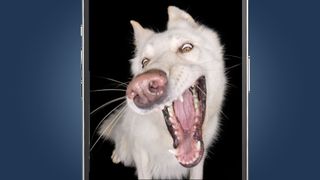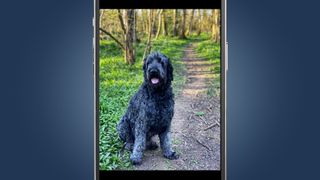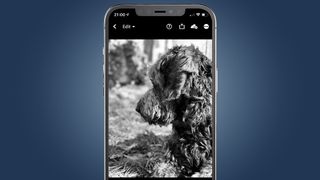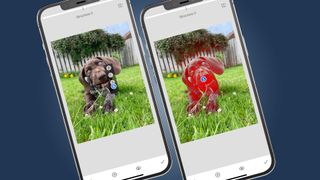How to take amazing pet and dog photos with your phone (according to the pros)
Capture your companion in their best light

If you’ve got a furry, feathered or scaled friend, then you’ll probably already have taken enough snaps to fill your camera roll. But if you’ve ever wondered how you can improve your pet shots or dog photos to give them a professional sheen, then we’ve got some training treats for you.
Using a smartphone to take pictures of dogs and pets makes a lot of sense. For starters, it’s likely you’ll always have the former with you, so you can quickly react to whatever adorable thing your furry friend is getting up to. Phones are also small, light and unobtrusive, unlike bigger cameras which might make nervous pets a little anxious.
Modern smartphones are also well-equipped to get great photos of your dog or pet. With various lenses available for different effects, you can have a lot of fun taking snaps, and it’s a great way to bond with your pet, too. You’ll probably find you use the ‘main’ lens most often, but an ultra wide-angle can create some fun and unusual effects, while a telephoto lens is ideal if you can’t get super close to your pet to take the shot.
That said, there’s plenty of other ways you can improve your photography, so we asked several pros to provide some tips that can quickly boost your dog photos or pet snaps. Our pros are using a variety of phones, but you should find that all the tips work with whatever model you’re using.
1. Reflect on things
Professional photographer Liz Gregg uses smartphones for lots of her imagery. She runs the hugely successful @blackwhite.gold Instagram account, formed after working on a shoot for Cosmopolitan magazine entitled ‘How to Make Your Dog Instafamous’. Currently, there’s an exhibition of her work taking place at Herne Bay seafront in the UK.
One of Liz’s best and most creative tips for photographing is to use the advantages of your smartphone to create fantastic reflection photographs.

“Reflections can really add to a photo. With the right light and background, they look kind of magical," she says. "Stand your dog just at the other side of a puddle, or even in it. Then turn your phone upside down so the lens is at the lower edge of the phone. Place the phone as close to the reflective surface as possible - in the example here, it’s a puddle," she adds.
Get daily insight, inspiration and deals in your inbox
Get the hottest deals available in your inbox plus news, reviews, opinion, analysis and more from the TechRadar team.
"Because of the way smartphones are built, it means reflection photos taken with them are often better than those snapped with a standard camera, as you can get the lens totally next to the reflection, which is what gives that dreamy, pristine, mirror-like effect” she says.
2. Make it a game
What dog (or cat) doesn’t like treats? You can turn your next photo session with your beloved pet into a game that you’ll all enjoy by incorporating treat time into it.
You might need some practice to get the best results, but with a bit of perseverance and patience, you should find that you get some truly eye-catching photos that will look fantastic on your Instagram page.

It’s something that Liz Gregg practices often with her own pet photography. “A really fun way to take a photo of your dog is to do so while it’s catching a treat. This requires a fast shutter speed, as the action is over in a split second," she says.
"If your camera phone has the option to select a shutter speed (something you’ll find in Pro or Advanced modes of many Android phones, or via several advanced camera apps for iOS), start with 1/1000 second and, if there’s still some blur, select an even faster speed," she says.
“If your phone doesn’t have that option, make sure you’re taking the photo outside on a bright day so the phone will automatically select a fast speed. It takes practice to get the timing right – one hand to throw the treat, the other to take the photo – but it’s worth the practice and I promise your dog will love it!” she adds.
3. Make use of portrait mode
Most recent smartphones have some sort of Portrait mode. While you’re probably used to using this with people, it’s also a great way to give your pet photography a boost.
Depending on the model of your phone, you might find this is called Portrait, Aperture, Live Focus or similar. Essentially, what you’re looking for is the opportunity to blur the background to recreate the look of using a DSLR or mirrorless camera with a portrait-style lens.

It can take some experimenting to get the best results. Professional photographer Jet Lendon, who hung up her ‘big’ camera after 13 years to shoot exclusively with an iPhone, and who now runs workshops under the brand Jet Black Squares to help others do the same, has some good advice.
“Definitely use ‘Portrait’ mode (or equivalent), but make sure you touch on the screen where your pet’s eyes are as this is what you want to be in focus," she says. "If you have a messy background, this works wonders in blurring it all away – but wherever possible, try and avoid messy distractions, moving to a cleaner or clearer position if you can" she adds.
4. Stoop down to their level
A quick and easy way to instantly improve your pet photography is to get down to their level. Yes, sometimes this will mean that you’re rolling around in dirt and mud – but your Instagram followers will surely reward you for it.
By placing yourself, or at least your phone, at the same level as your dog, cat or other type of pet, you’ll produce a much more natural and realistic result, and show off your pet in all their glory. Towering above them to take the shot can often result in strange and unflattering perspectives.

If it’s difficult to get down to their level, try to bring them up to yours. Steps and staircases are a great way to do this, but you could also try turning your phone upside down to give you a little bit of extra reach.
You should also try not to worry too much about your pet posing perfectly for you. “Don’t panic if your pets refuse to look at you – natural shots are often the best, she says. "Bribery works well as a last resort, try placing a treat or a favorite squeaky too just at the top of your phone and you should find you quickly grab their attention.”
5. Edit your pet photos
Once you’ve taken a snap, you can improve them even further by using some simple editing tricks directly on your phone.
A popular app used by various photographers, including professionals, is Snapseed. Jo Bradford’s latest book Smart Phone Smart Photo Editing (available to pre-order now) comes packed with all sorts of tips for using the app across a variety of subjects.
For pets, she advises the following: “Color can create a sort of blindness to the texture and tone of animals’ fur and coats. Consider converting color images of your pets to black and white to achieve more detail and bring to the fore the full range of textures", she says.

“However, if you choose to stick with color, use selective adjustments in apps such as Snapseed to brighten darker areas of their fur / coats, especially if your pet is darker colored", she adds.
“As with any portrait (human or animal), it is essential to get the eyes in focus, with catchlights an added bonus if you can capture them. You can also make eyes look brighter and sharper by using Snapseed’s ‘Selective’ tool to brighten and structure them” she says.
- These are the best photo editing apps you can download right now

Mark is TechRadar's Senior news editor. Having worked in tech journalism for a ludicrous 17 years, Mark is now attempting to break the world record for the number of camera bags hoarded by one person. He was previously Cameras Editor at both TechRadar and Trusted Reviews, Acting editor on Stuff.tv, as well as Features editor and Reviews editor on Stuff magazine. As a freelancer, he's contributed to titles including The Sunday Times, FourFourTwo and Arena. And in a former life, he also won The Daily Telegraph's Young Sportswriter of the Year. But that was before he discovered the strange joys of getting up at 4am for a photo shoot in London's Square Mile.
Most Popular
